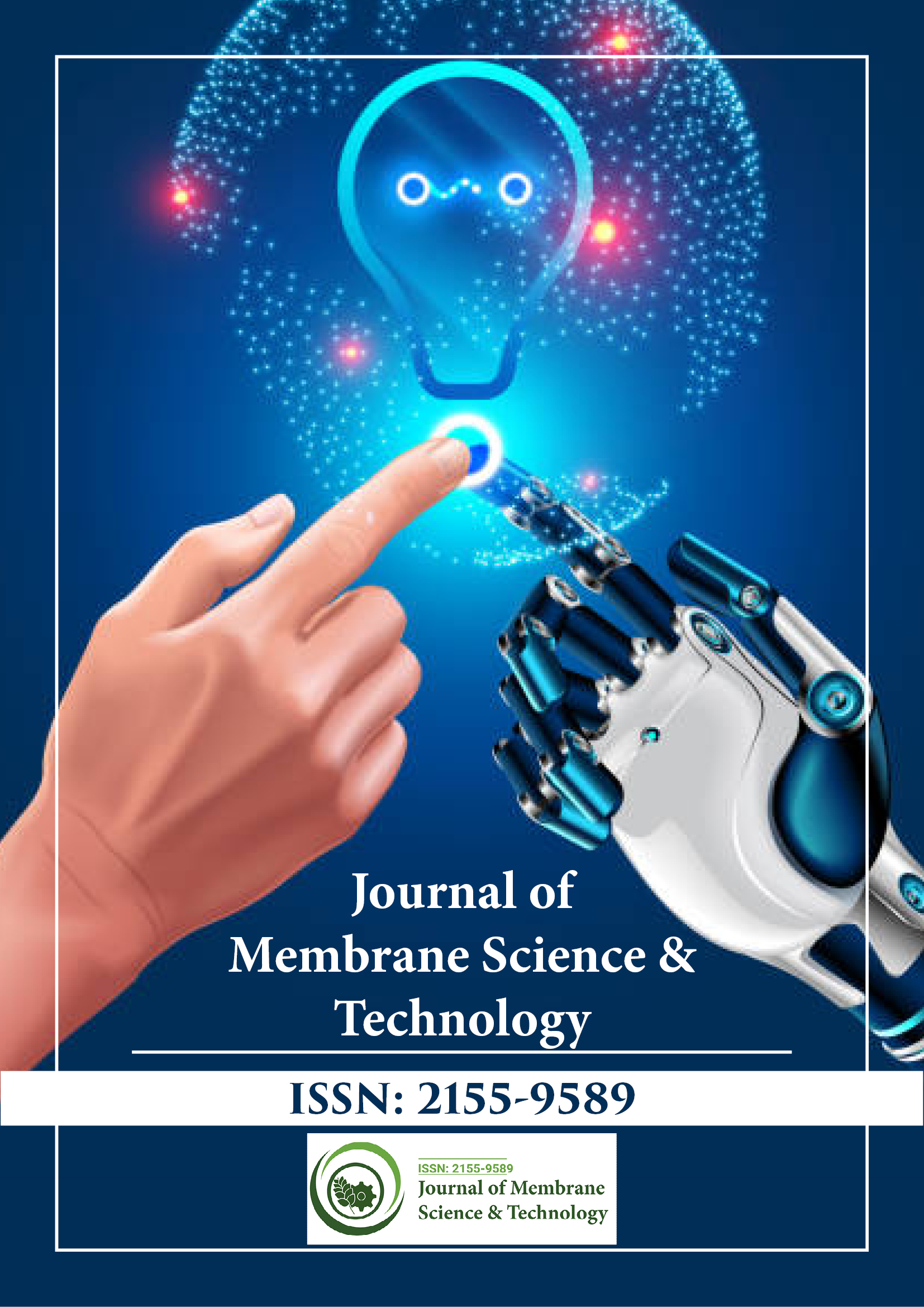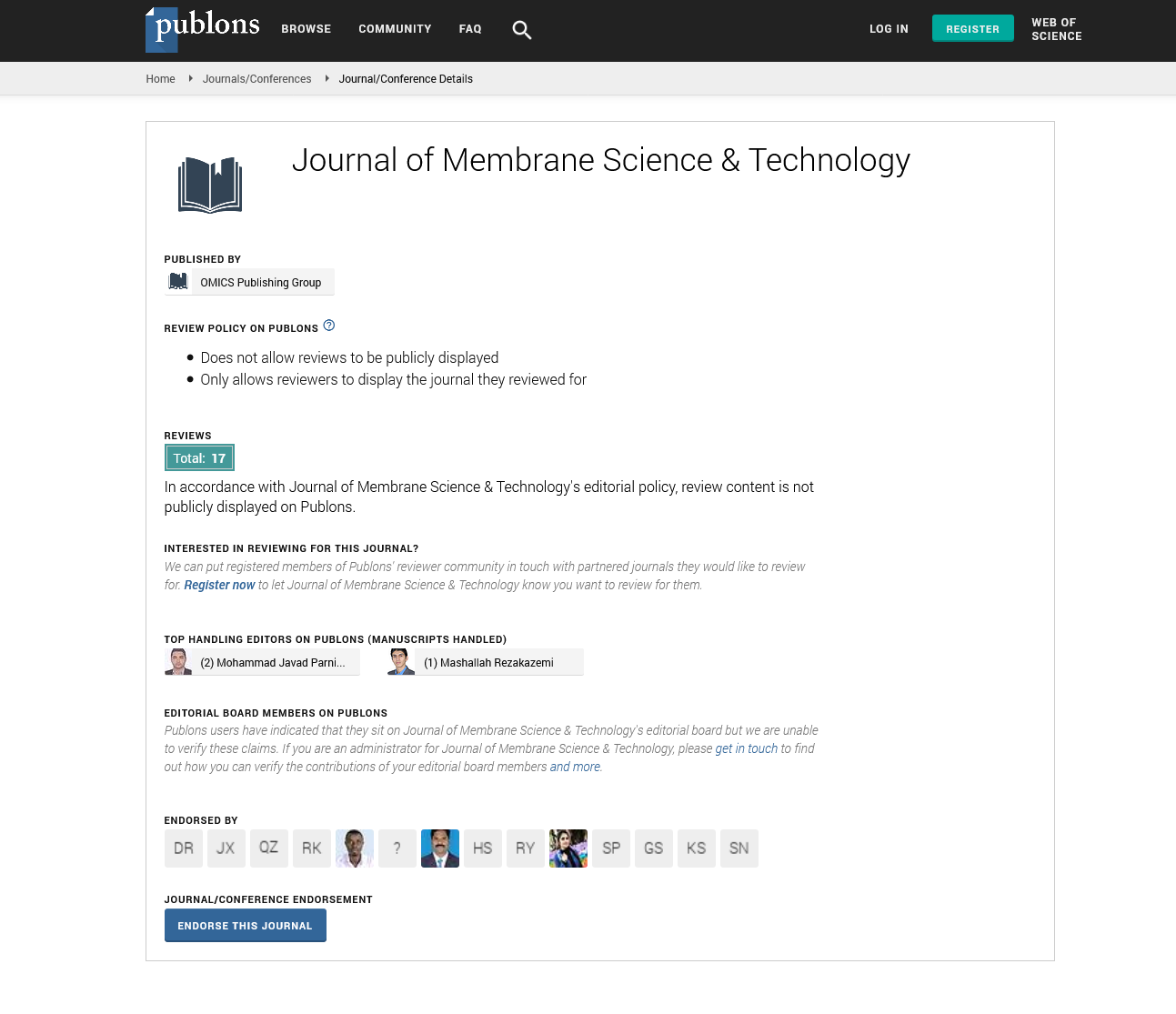Indexed In
- Open J Gate
- Genamics JournalSeek
- Ulrich's Periodicals Directory
- RefSeek
- Directory of Research Journal Indexing (DRJI)
- Hamdard University
- EBSCO A-Z
- OCLC- WorldCat
- Proquest Summons
- Scholarsteer
- Publons
- Geneva Foundation for Medical Education and Research
- Euro Pub
- Google Scholar
Useful Links
Share This Page
Journal Flyer

Open Access Journals
- Agri and Aquaculture
- Biochemistry
- Bioinformatics & Systems Biology
- Business & Management
- Chemistry
- Clinical Sciences
- Engineering
- Food & Nutrition
- General Science
- Genetics & Molecular Biology
- Immunology & Microbiology
- Medical Sciences
- Neuroscience & Psychology
- Nursing & Health Care
- Pharmaceutical Sciences
Perspective - (2025) Volume 15, Issue 2
Modern Technologies and Strategies for Effective and Sustainable Wastewater Treatment Today
Arthanare Swaran*Received: 30-Apr-2025, Manuscript No. JMST-25-29444; Editor assigned: 02-May-2025, Pre QC No. JMST-25-29444; Reviewed: 16-May-2025, QC No. JMST-25-29444; Revised: 23-May-2025, Manuscript No. JMST-25-29444; Published: 30-May-2025, DOI: 10.35248/2155-9589.25.15.426
Description
Wastewater treatment is an essential process for protecting public health, preserving environmental quality and ensuring the sustainable management of water resources. As populations grow, urbanization increases and industrial activities expand, the generation of wastewater also rises, bringing with it complex challenges related to contaminants, resource recovery and energy consumption. Modern wastewater treatment combines physical, chemical and biological processes to remove pollutants, recover valuable resources and produce effluent that can be safely discharged or reused. The evolution of treatment technologies reflects a shift from conventional pollution control to integrated water management and sustainability.
Wastewater can be broadly classified into domestic, industrial and stormwater categories, each with distinct characteristics and treatment needs. Domestic wastewater primarily consists of organic matter, nutrients and pathogens, while industrial wastewater may contain heavy metals, toxic chemicals and other hazardous substances depending on the production processes involved. Effective treatment strategies must therefore be tailored to the specific composition and volume of the wastewater source.
The traditional approach to wastewater treatment typically involves three main stages: primary, secondary and tertiary treatment. Primary treatment focuses on the physical removal of large solids and suspended particles through screening, sedimentation and grit removal. This stage is essential for protecting downstream processes from clogging and mechanical damage, though it removes only a portion of the total pollutant load.
Secondary treatment uses biological processes to degrade organic matter and reduce Biochemical Oxygen Demand (BOD). Activated sludge systems, trickling filters and rotating biological contactors are commonly used in this stage. In an activated sludge process, microorganisms consume organic pollutants while suspended in aerated tanks, forming biomass flocs that are later separated in a clarifier. This method is effective and widely used, but requires careful control of oxygen supply, sludge age and microbial activity to maintain efficiency.
Tertiary treatment, or advanced treatment, further polishes the effluent by removing nutrients, pathogens, trace organics and residual solids. Processes in this stage include filtration, disinfection (using chlorine, ozone, or ultraviolet light), nutrient removal (especially nitrogen and phosphorus) and membrane filtration technologies such as ultrafiltration and reverse osmosis. Tertiary treatment is crucial in applications where treated water is reused for irrigation, industrial cooling, or even potable water supply.
With increasing emphasis on sustainability and resource recovery, modern wastewater treatment plants are evolving into water resource recovery facilities. These facilities are designed not only to treat wastewater but also to extract energy, nutrients and clean water. Anaerobic digestion of sludge is a key example, producing biogas that can be used to generate heat and electricity. Nutrient recovery technologies, such as struvite precipitation, allow the recovery of phosphorus and nitrogen in a usable form for fertilizers.
Membrane Bioreactors (MBRs) represent a significant advancement in secondary and tertiary treatment. By combining biological treatment with membrane filtration, MBRs produce high-quality effluent in a compact footprint. They are especially useful in space-constrained urban settings and for decentralized treatment systems. MBRs offer excellent pathogen removal and reduce the need for further disinfection, though they come with higher energy demands and operational complexity.
Constructed wetlands and other nature-based solutions are gaining attention as sustainable alternatives for wastewater treatment, especially in rural or low-income regions. These systems use natural vegetation, soil and microbial processes to treat wastewater passively. They are cost-effective, lowmaintenance and provide co-benefits such as habitat creation and carbon sequestration, though they typically require larger land areas and may have lower treatment capacities.
Decentralized wastewater treatment systems are also becoming increasingly relevant, particularly in rapidly growing peri-urban areas or locations without access to centralized infrastructure. These systems treat wastewater close to its source and can be designed for reuse, reducing the burden on central plants and distribution networks. Technologies used in decentralized systems include septic tanks, bio-digesters and modular MBRs.
Industrial wastewater treatment presents unique challenges due to the wide variety of contaminants involved. Advanced Oxidation Processes (AOPs), chemical precipitation, ion exchange and adsorption techniques are commonly used to target specific pollutants such as heavy metals, organic solvents and pharmaceutical residues. Regulations increasingly require industries to implement Zero-Liquid Discharge (ZLD) strategies, where wastewater is fully treated and reused within the facility, with minimal or no discharge into the environment.
The integration of digital tools, automation and artificial intelligence is enhancing the performance and reliability of wastewater treatment systems. Real-time monitoring, data analytics and predictive maintenance enable operators to optimize process efficiency, detect anomalies early and reduce energy consumption. Smart sensors can track parameters like turbidity, pH, dissolved oxygen and chemical concentrations, supporting responsive and adaptive control systems.
Climate change and emerging contaminants such as micro plastics, endocrine-disrupting compounds and antibioticresistant bacteria pose new challenges for wastewater treatment. Research is ongoing to develop advanced materials, nanotechnologies and hybrid systems capable of addressing these threats. At the same time, there is growing emphasis on public awareness, regulatory enforcement and cross-sector collaboration to ensure that wastewater treatment contributes to broader environmental and public health goals.
Conclusion
In conclusion, wastewater treatment is no longer just about pollution removal; it is a cornerstone of circular economy and sustainable development. As pressures on global water resources increase, the role of innovative, efficient and resilient treatment systems becomes even more critical. By embracing technological advancements, promoting decentralized and nature-based solutions and integrating resource recovery into treatment goals, the future of wastewater management promises to be more adaptive, sustainable and beneficial to both people and the planet.
Citation: Swaran A (2025) Modern Technologies and Strategies for Effective and Sustainable Wastewater Treatment Today. J Membr Sci Technol.15:426.
Copyright: © 2025 Swaran A. This is an open-access article distributed under the terms of the Creative Commons Attribution License, which permits unrestricted use, distribution and reproduction in any medium, provided the original author and source are credited.

